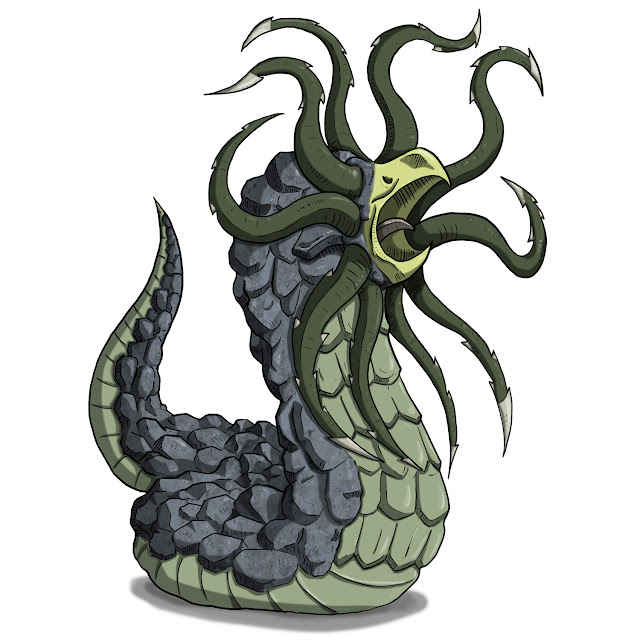D&D Basic Monsters: Grick
The Grick did not make its debut in D&D until 3rd edition, when it was thrust into stardom, making an appearance in the Monster Manual. From there on it has appeared in the main Monster Manual of all following editions.
Basically a snake with tentacles, it might bring creatures like the Dhole or Cthonian from Lovecraftian horror to mind, though the Grick lacks the massive size of those nightmares.
In the 3rd edition Monster Manual describes them as having four tentacles, and while this is not stated in the description of the 5th edition Grick, official artwork still usually depict it with four tentacles. One can only assume that the artist here has some kind of tentacle fetish.
D&D Basic Monsters: Nothic
The Nothic is a fairly new addition to the D&D monster roster, debuting in the 2003 Miniatures Handbook for edition 3.5 (alongside the Kruthic that's also stuck with the game since then), getting a star billing in 5th edition, not only appearing in the Monter Manual, but also the Starter Set adventure Lost Mines of Phandelver. The Nothic doesn't seem to be based on any mythical creature, though the single central eye is a staple of many D&D aberrations, usually those related to beholders. Alternatively, the Pixar movie Monsters Inc. was released the year prior to the Nothic making its appearance, so maybe maybe it's really based on Mike Wazowski ?
None of the descriptions given of the Nothic ever specify which colour it has, so various artists have chosen various colours. Depending on where you look, you can get your Nothic in green, blue, purple, pink and red. The original Nothic was however a pale greenish yellow, so that's what we've chosen here (plus, choosing a greenish tint makes it look more like said Mike Wazowski, which is always fun - now "put that thing back where it came from, or so help me....")
D&D Basic Monsters: Gargoyle
In D&D the gargoyle appeared as early as the original book, probably due to their close relation to medieval imagery and architecture. From the beginning gargoyles were immune to damage from non-magic weapons, a trait they've retained throughout all editions of the game (with the exception of 4th edition), even though the rules for immunity/resistance to non-magical weapons have changed significantly though the editions.
In real life, a gargoyle is a specific stone decoration, usually in the form of some fantastic creature, used in Gothic architecture to lead water away from roofs - medieval gutters in other words. The name (from French and Latin) is possibly a reference to the gargling (or gurgling) sound it makes as water flows through them. Any figure on a building not used to convey water is known as a grotesque, and since the D&D Gargoyle has no powers relating to spewing water, they should technically be called Grotesques.
D&D Basic Monsters: Warhorse
Although a war horse technically is any horse trained not to panic or bolt in combat, regardless of size. In a medieval setting, however, it makes sense that warhorses are larger specimens capable of carrying a plate mailed knight while wearing cumbersome armour (barding) and being able to trample lesser foes underfoot.
The most famous of the medieval war horses were the destrier, used in jousts and tournaments as well as on the battlefield. They were known for their great size and strength, though they were also extremely expensive, and most knights would use what was known as a courser, a slightly smaller, but strong and fast type of horse. In large battles, the knight would usually ride to the site of the battle on a different horse (a palfrey) to ensure that the warhorse was as fresh and rested as possible before charging.






















No comments :
Post a Comment